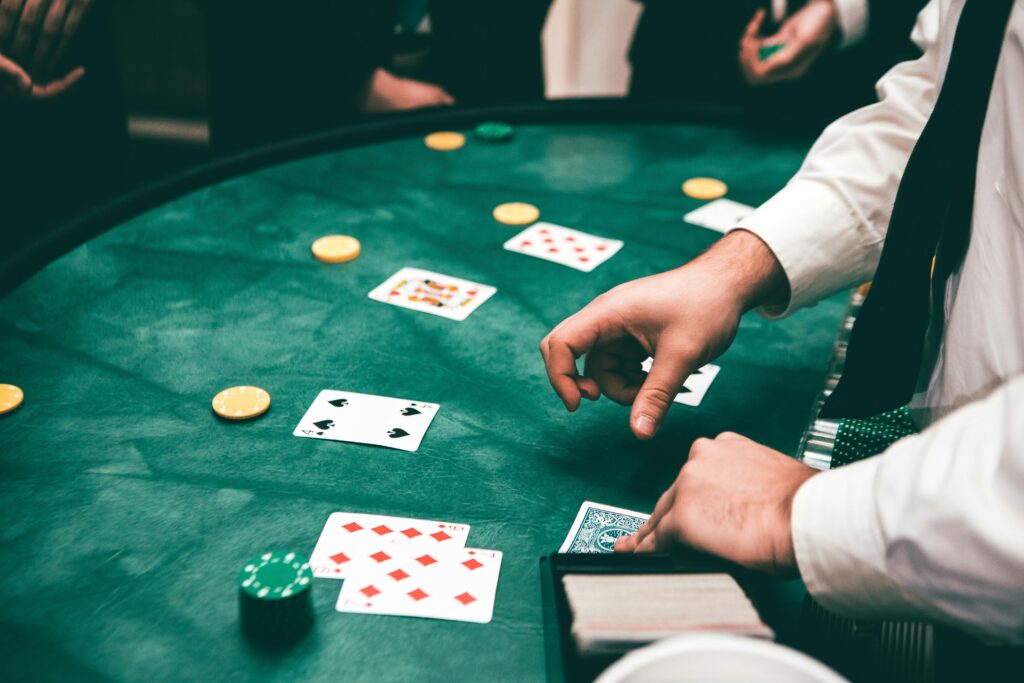The Psychology Behind Blackjack
In the kaleidoscopic universe of casino games, blackjack emerges as a timeless masterpiece. Beyond the veneer of cards and the dealer’s table lies a captivating symphony of psychology, intricately weaving the experiences of both players and the house.
Are you interested in embarking on a journey into the labyrinth of chance, strategy and human behavior that paints the distinctive psychological portrait of blackjack? If your answer is “yes” then you’ve come to the perfect place and all you have to do is keep reading.

Decoding the Essentials
At its core, blackjack is a ballet of cards where players aim to approach 21 without breaching its confines. The dealer orchestrates the shuffle and players engage in a strategic dance based on the strength of their hand and the revealing face of the dealer’s card. Hidden beneath its apparent simplicity lies a tapestry of psychological nuances that adds to its enduring allure.
Thriving on Risk and Reward
The beating heart of blackjack pulsates with risk and reward. Players must choreograph their moves – hit, stand, double down, or split – guided by the allure of potential outcomes and their individual risk thresholds. This constant evaluation of risk imbues each hand with psychological intensity.
Under the Spotlight of Swift Decision-Making
In the fast-paced realm of blackjack, the brisk tempo demands rapid decision-making. Players find themselves navigating a complex landscape where they must swiftly process information, deftly juggling the dynamic interplay of odds, hand strength and the looming specter of the dealer’s potential hand.
This relentless pace not only intensifies the gameplay but also amplifies the psychological drama inherent in each hand. The pressure cooker of decision-making adds layers of intrigue, as players must make split-second choices that can spell the difference between victory and defeat. In this accelerated cognitive ballet, the psychological stakes are heightened, creating an atmosphere where the mind is both the conductor and the audience, orchestrating a suspenseful narrative that unfolds with each turn of the cards.
The Emotional Ballet
The ebb and flow of blackjack, from the euphoria of victory to the sting of defeat, craft an emotional ballet for players. Navigating these emotional peaks and valleys becomes an art, shaping subsequent decisions as players ride the waves. For those who like to play blackjack online, there’s a tad of ease regarding the emotional ballet. At home, you can contain yourself easier behind the screen and the gaming decorations in your room.
The Psychology of Player Behavior
Optimism and the Illusion of Mastery: A streak of optimism often colors player perceptions, fostering the illusion that their decisions hold sway over the outcome. This illusion of mastery enhances the allure of blackjack, offering players a semblance of control in a game dominated by chance.
The Weight of Loss Aversion
Loss aversion, a psychological anchor, holds sway over blackjack players. The pain of losses is keenly felt, influencing decision-making as players strive to sidestep the emotional toll of setbacks.
Navigating the Gambler’s Galaxy
The gambler’s fallacy, a cognitive quirk, finds its place at the blackjack table. Striking a balance between acknowledging probability and avoiding fallacious thinking is pivotal for players seeking strategic clarity.
Social Choreography
The communal aspect of blackjack, particularly in live settings, introduces a social dimension. Interaction with the dealer and fellow players paints a communal canvas, shaping the experience with elements of camaraderie or rivalry.
The House Edge and Casino Orchestration
- The Psychological Symphony of the House Edge: The presence of a house edge in blackjack introduces a statistical undertone. Comprehending the house edge influences player expectations, emphasizing the need for strategic play and realistic outlooks.
- Juxtaposing Free Will and Mathematical Certainty: A delicate dance unfolds between free will and mathematical certainty in blackjack. While players exercise their decisions with intuition and strategy, the underlying mathematics silently guides the long-term outcomes.
- Atmospheric Allegro: Casinos meticulously craft the ambiance and atmosphere of blackjack tables, introducing an atmospheric allegro. The design, lighting and overall setting contribute to the psychological overture, enhancing the allure of the game for players.
Strategies and the Cognitive Ballet
- Counting Cards: The Cognitive Sonata: Card counting, a strategic art, introduces a cognitive sonata to blackjack. Skillful players engage in mental arithmetic to track card ratios, influencing their betting decisions and transforming the game into a cerebral performance.
- Memory and Tactical Choreography: Memory emerges as a virtuoso player in blackjack strategy. Players must recall not only their own cards but also the dealer’s face-up card, orchestrating their strategy in a cognitive ballet that adds depth to the gameplay.
Conclusion
Beyond the shuffle of cards and the clink of chips, the psychology behind blackjack is a mesmerizing symphony. The interplay of risk, reward, swift decision-making and emotional choreography shapes the player’s experience. Understanding the psychological intricacies, both in player behavior and casino orchestration, unveils the artful symphony that defines blackjack as a timeless and captivating casino classic. As players take their seats at the blackjack table, they enter not just a game of chance but a performance where psychology, strategy and the whims of probability entwine in a perpetual dance, creating an unforgettable tableau at the heart of the casino realm.
More on https://neon-aesthetic.com/best-casino-websites-in-2024/.